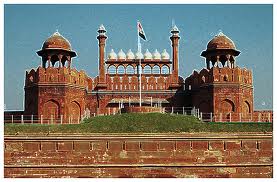Taj Mahal ia a Persian/Urdu word meaning "crown of buildings is a mausoleum located in Agra, India. It was built by Mughal emperor Shah Jahan in memory of his third wife Mumtaz Mahal , The Taj Mahal is widely recognized as "the jewel of Muslim art in India and one of the universally admired masterpieces of the world's heritage.Taj Mahal is the finest example of Mughal architecture, a style that combines elements from Persian, Turkish and Indian architectural styles . The construction began around 1632 and was completed around 1653, employing thousands of artisans and craftsmen.
HISTORY OF TAJ MAHAL
In 1631, Shah Jahan, emperor during the Mughal empire's period of greatest prosperity, was grief-stricken when his third wife, Mumtaz Mahal, died during the birth of their 14th child, Gauhara Begum. Construction of the Taj Mahal began in 1632. The Taj Mahal incorporates and expands on design traditions of Persian architecture and earlier Mughal architecture. While earlier Mughal buildings were primarily constructed of red sandstone, Shah Jahan promoted the use of white marble inlaid with semi-precious stones, and buildings under his patronage reached new levels of refinement.
ARCHITECTURE
The tomb is the central focus of the entire complex of the Taj Mahal. This large, white marble structure stands on a square plinth and consists of a symmetrical building with iwan (an arch-shaped doorway) topped by a large dome and finial. Like most Mughal tombs, the basic elements are Persian in origin.
The marble dome that surmounts the tomb is the most spectacular feature. Its height of around 35 meters (115 ft.) is about the same as the length of the base, and is accentuated as it sits on a cylindrical "drum" which is roughly 7 meters (23 ft.) high. Because of its shape, the dome is often called an onion dome or amrud (guava dome). The top is decorated with a lotus design, which also serves to accentuate its height. The shape of the dome is emphasized by four smaller domedchattris (kiosks) placed at its corners, which replicate the onion shape of the main dome.


The main finial was originally made of gold but was replaced by a copy made of gilded bronze in the early 19th century. This feature provides a clear example of integration of traditional Persian and Hindu decorative elements. The finial is topped by a moon, a typical Islamic motif whose horns point heavenward. Because of its placement on the main spire, the horns of the moon and the finial point combine to create a trident shape, reminiscent of traditional Hindu symbols of SHIVA.
EXTERIOR DECORATION
The exterior decorations of the Taj Mahal are among the finest in Mughal architecture . Throughout the complex, passages from the Qur'an are used as decorative elements. Recent scholarship suggests that the passages were chosen by Amanat Khan. The calligraphy on the Great Gate reads "O Soul, thou art at rest. Return to the Lord at peace with Him, and He at peace with you."
On the lower walls of the tomb there are white marble dados that have been sculpted with realistic bas relief depictions of flowers and vines. The marble has been polished to emphasize the exquisite detailing of the carvings and the dado frames and archway spandrels have been decorated with pietra dura inlays of highly stylized, almost geometric vines, flowers and fruits. The inlay stones are of yellow marble, jasper and jade, polished and leveled to the surface of the walls.
INTERIOR DECORATION
The interior chamber of the Taj Mahal steps far beyond traditional decorative elements. Here, the inlay work is not pietra dura, but a lapidary of precious and semiprecious gemstones. The four central upper arches form balconies or viewing areas, and each balcony's exterior window has an intricate screen or jail cut from marble. In addition to the light from the balcony screens, light enters through roof openings covered by chattris at the corners. Each chamber wall has been highly decorated with dado bas-relief, intricate lapidary inlay and refined calligraphy panels, reflecting in miniature detail the design elements seen throughout the exterior of the complex.
THE GARDEN
The complex is set around a large 300-metre (980 ft.) square charbagh or Mughal garden. The garden uses raised pathways that divide each of the four quarters of the garden into 16 sunken parterres or flowerbeds. A raised marble water tank at the center of the garden, halfway between the tomb and gateway with a reflecting pool on a north-south axis, reflects the image of the mausoleum. The raised marble water tank is called al Hawd al-Kawthar, in reference to the "Tank of Abundance" promised to Muhammad.
CONSTRUCTION
The Taj Mahal was built on a parcel of land to the south of the walled city of Agra. Shah Jahan presented Maharajah Jai Singh with a large palace in the center of Agra in exchange for the land. The plinth and tomb took roughly 12 years to complete. The remaining parts of the complex took an additional 10 years and were completed in order of minarets, mosque and jawab, and gateway. The total cost has been estimated to be about 32 million Rupees at that time. The Taj Mahal was constructed using materials from all over India and Asia and over 1,000 elephants were used to transport building materials.












 03:31
03:31
 Tech Hights
Tech Hights





































